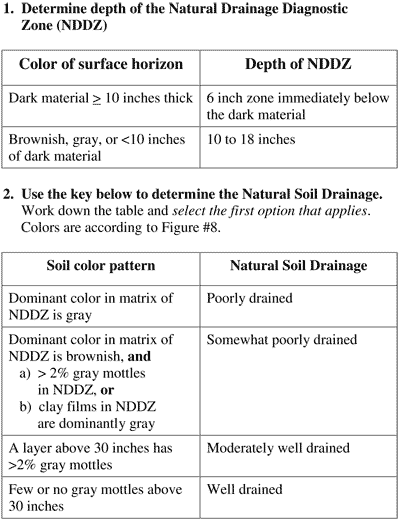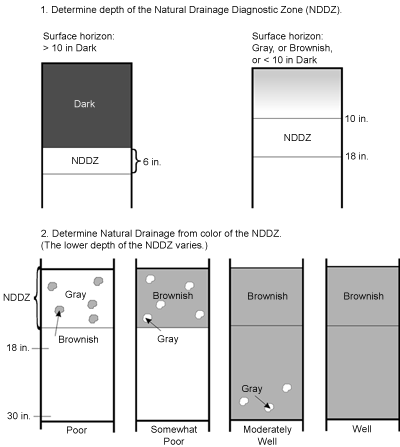II. SOIL AND LANDSCAPE PROPERTIES
Natural Soil Drainage Next Section>>
Subsections:Significance of color | Determining natural soil drainage
Natural soil drainage represents the moisture and oxygen conditions of soils in their natural condition throughout the year. Natural drainage determines which soils are wet enough to qualify as wetlands that may need to be preserved. It is also determines which soils need drainage systems to remove subsoil water, allow air to enter the subsoil, and hasten drying of surface horizons to facilitate crop production. Natural drainage indicates which soils may have a good subsoil source of water to support crops during dry periods. In residential areas, it indicates which soils are suitable for onsite wastewater disposal systems and the type of system that is best adapted to a soil.
Many of the color characteristics that reflect natural soil drainage remain after a drainage system has been installed. These characteristics still can be used to indicate the natural wetness conditions of artificially drained soils.
Wet soil conditions occur when rainfall or additions of water from nearby areas exceed removal by downward drainage, lateral (sideways) movement, or plant utilization. Wet soils are caused by slowly permeable or impermeable layers in the subsoil or below that maintain a water table near the soil surface for several weeks or months a year.
Soil color depends on the kinds and amounts of a few strong pigments in soils. Most soil minerals are colorless or light gray. Organic matter and iron oxide minerals are the most common pigments that give the soil other colors. Organic matter colors the soil black; the greater the amount of organic matter, the darker the soil color. Iron oxide minerals color the soil brown or red. Goethite (FeOOH) is a common iron oxide mineral that colors the soil brown or yellow (hues of 7.5YR to 5Y). Rust, like on a plow left outside, is goethite. Hematite (Fe2O3) is another common iron oxide mineral that colors the soil red (hues of 5YR or redder). Soil that contains almost no organic matter or iron oxide is usually gray because one sees the gray color of the common soil minerals.
Air moves readily through well-drained soil horizons and the iron (Fe) released when primary minerals weather is oxidized (reacts with the oxygen in air) to form goethite and/or hematite, giving rise to brownish or reddish colors. Horizons in poorly and somewhat poorly drained soils are water-saturated for part of the year. Because the soil pores are filled with water, no oxygen is present. During times when oxygen is excluded, goethite and hematite dissolve out of some areas of the horizon (iron is reduced), so one sees the gray colors of the remaining soil minerals instead of the brownish hues of the Fe minerals. When the water table goes down, oxygen again returns to the horizon; iron is oxidized to form goethite in some areas and a mixed brown and gray color pattern develops. This mottled pattern (mixed brown and gray colors) is common in somewhat poorly drained soils. Subsoils of poorly drained soils may be mottled or practically all gray.
The material inside peds is called matrix material. It includes the “ordinary” soil material, but excludes special features such as coarse fragments, worm channels, concretions (hardened material), clay films, silt coats, and other surface features. Matrix material may have several colors. The main color is the dominant color, and the minor color is the mottle color. Mottles are flecks, spots, or patches of one color in a background of the dominant color (Plate 14). Mottles may be any color and various sizes. Sometimes they occupy just about as much area as the dominant color.
Gray soil colors (Fig. 12), either as the dominant or the mottle color, indicate poorer natural drainage. Reddish brown to black mottles and concretions often indicate restricted drainage, but they are not the primary property used to judge drainage. Soils with restricted drainage must have some gray colors inside the peds, gray clay films on the peds, or gray colors both in peds and in clay films. The amount of gray features and their depth in the profile indicate the drainage class.
To determine natural drainage, it is necessary to distinguish clay films or coats from silt coats and carbonate coats on soil peds (natural chunks of soil). A clay film coats a ped like a layer of paint. It often has a somewhat shiny or waxy appearance (Plate 15). It can be in any of the three main color classes, but often it is usually somewhat different in color from the inside of the ped. This can be demonstrated when a surface cut through a soil profile with a spade looks different than a picked surface. The picked surface shows the surfaces of peds and the cut surface shows the interior of peds. Another way to see the difference is to cut through peds with a small knife or spatula.
Silt coats and carbonate coats occur in soil horizons that may or may not be periodically saturated with water so they are not indicative of soil drainage. In contrast to clay films, silt coats and carbonate coats have a grainy or dusty appearance (Plate 13). Usually they appear light gray to white when they are dry (Munsell values of 7 or 8). When water is dropped on dry silt coatings, they practically become invisible if the coating is thin. Clay films, on the other hand, are often darker gray (value 4 or 5) or brownish. Carbonate coats are calcareous (fizz with dilute HCl) and they coat peds, usually large ones, that are also calcareous throughout. Typically they are in dense till. They appear much like the light colored silt coats in fragipans (Plate 12, 2 1/2 to 4 ft. deep, Plate 16).
In summary, clay films appear waxy or painted on and are usually darker gray or brownish when moist. Silt coats and carbonate coats appear dusty or grainy and are usually lighter gray when moist and very light gray to white when dry.
In some soils, there may be a few spots of gray colors that do not reflect an overall wet soil condition. For example, a freshly-weathered mineral may be gray, or an isolated sand pocket in the soil may be gray. To recognize mottling for soil evaluation, at least 2% of the soil material must be the color of the mottle.
The “brownish” color class (Fig. 12) includes a wide range of colors. In many well drained soils, such as Parr, Ockley, Chelsea, Trappist, Alford, and Hosmer (Plates 5, 6, 7, 10, 11, and 12), the B horizon colors have 10YR or 7.5YR hues. In well drained soils formed in weathered limestone (Plate 9), the “brownish” colors tend toward redder hues (2.5YR and 5YR). In poorly and somewhat poorly drained soils (Plate 4, BC of Brookston), the “brownish” colors tend toward more olive hues (2.5Y and 5Y).
back to topDetermining Natural Soil Drainage
Natural soil drainage is judged by the color pattern of the subsoil (see the Soil Color section). First, look at the overall color of the subsoil, which should be moist if possible, to get an important first impression of the drainage. Well or moderately well-drained soils appear brownish, while poorly drained soils appear gray. Somewhat poorly drained soils generally appear gray because they usually have gray clay films, many of which show in the wall of the pit. Directions for determining natural soil drainage are given in Table 4. First determine the depth of the Natural Drainage Diagnostic Zone (NDDZ, or “no-doze” if you want to say it). After that, key out the drainage class by selecting the first option that applies to the soil in question.
For example, if the NDDZ is dominantly gray, the soil is poorly drained and you do not need to go further down Table 4. If the NDDZ is dominantly brownish, but has gray colors in it, the soil is somewhat poorly drained, and again, you do not need to go further down the table. If the soil has very few or no gray colors in the NDDZ, but has them above 30 inches, the soil is moderately well drained. If it lacks gray colors in the upper 30 inches, it is well drained. See Table 4 for required amounts of gray colors. The procedure for determining natural drainage classes is illustrated in Fig. 18.

Table 4. Guidelines for determining natural soil drainage
class.

Fig 18. Diagram illustrating how to 1) determine depth of the Natural Drainage Diagnostic Zone, and 2) determine the natural drainage class.
Print this chart!
Click here for GIF
Click here for Word
Click here for PDF
- In special situations, official judges may give depths for the NDDZ that are different from the standard depths listed in Table 4 and Fig. 18. These depths will be written on the site card. These are some examples where depths might be given:
- If the soil is severely eroded, the NDDZ might need to be shallower than 10 to 18 inches to show the correct drainage class.
- If there is significant deposition on the soil surface, the NDDZ might need to be deeper.
- If it is difficult to detect the bottom of the dark layer, giving the depth of the NDDZ will allow contestants to use the same zone as the official judges.
- In some soils, the uppermost gray mottles are at 18 inches, the boundary depth, and contestants would not know which way to mark their card. If the NDDZ was changed to 14 to 24 inches, it would clearly contain mottles; if it was changed to 6 to 16 inches, it would clearly be free of mottles.
Changing depth of the NDDZ does not change the next zone to examine, between the bottom of the NDDZ and 30 inches.
Use Table 4 to determine Natural soil drainage.
If the Natural Drainage Diagnostic Zone determined according to the table does not represent the soil very well, official judges may give the zone on the site card, or they may give the Natural Soil Drainage itself.
back to top
